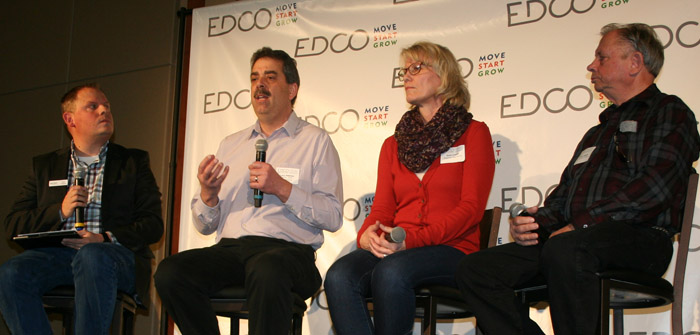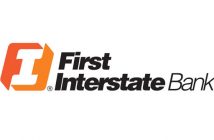((L-R) The Workforce of the Future panelists Evan Dickens, who moderated, Larry Holeman, Karin Crouch and Gary Lynch | Photo by Ronni Wilde)
EDCO (Economic Development for Central Oregon) hosted its annual luncheon on February 13, enjoying a sold-out, packed audience of 750 attendees. The event featured a panel presentation about EDCO’s internship program, and keynote speaker Lindsey Pollak, a New York Times bestselling author and multigenerational workforce expert.
The luncheon was kicked off with a welcome by Connie Druliner, EDCO’s president of the board for 2020. “EDCO started with $30,000, and now we have a $1.4 million budget. The future can happen to us, or with us,” she said, addressing the future with EDCO. “We can make a difference and lighten the load for someone else. We get by with a little help from our friends. We remain vital. I love a challenge, and I hope you do too.” Roger Lee, founder and CEO of EDCO, continued the welcome by thanking the sponsors, and Dr. Becky Johnson, vice president of OSU-Cascades, rounded out the welcome.
The panel discussion, which focused on the importance of internships, was presented by panelists Karin Crouch, a parent and teacher at Ridgeview High School in Redmond; Gary Lynch, owner of Lynch Pro-formance auto parts store in Redmond; and Larry Holeman, regional managing director of Youth CareerConnect and EDCO’s internship coordinator for Redmond and Sisters. The panel was moderated by Evan Dickens, partner and shareholder with Jones & Roth CPAs, and offered information and advice to business owners about bringing on interns. “The benefits in having an intern are across the board,” said Holeman. “The students want to learn and be given tasks. It’s important that their work experience parallels what they are studying in school to make sure they are on the right career path.”
“Doing what all the other students do doesn’t work,” said Crouch. “The students need to do something unique. They need to know how to dress for work and be confident among adults. Don’t just ask a middle schooler how school is, ask them how their career development is going.” Lynch added, “It’s a great feeling to help somebody else help themselves.”
“To add my own perspective, six of 12 partners of Jones & Roth started as interns at Jones & Roth,” said Dickens.
Following the panel discussion, keynote speaker Pollak gave her presentation, based on her book The Remix: How to Lead and Succeed in the Multigenerational Workplace. “This topic is important because we have five distinct generations in the workforce. This has never, ever happened before in our country’s history,” she said. “This is due to expansion in both directions. People are working longer and later than ever before and entering the workforce younger. There are people over 85 years old still working. Those who look at resumes are looking at them from 38-year-olds and 78-year-olds applying for the same job.”
Pollack cited the five generations as follows:
- Traditionalists/Silents (born 1945 or earlier)
- Baby Boomers (born 1946 to 1964)
- Generation Xs (born 1965 to 1980)
- Millennials/Generation Ys (born 1981 to 1996)
- Generation Zs (born 1997 and later)
The challenge with this situation, she said, is that traditionally, the older generations have a tendency to shame younger generations. “The minute we have any longevity, we start to criticize the newer ones. We have literally been shaming younger generations throughout all humanity. No generation has ever been as shamed and criticized as the Millennials. But what we are saying about them really isn’t any worse than what we’ve said about previous generations; we just have more social media outlets to say it on. Now, we have Gen Z coming in to make fun of.” Pollak cited the quote, “I see no hope for the future of our people if they are dependent on the frivolous youth of today,” asking the audience to guess which generation had said it. “This was from Hesiod, in the 8th Century B.C.,” she said with a laugh.
“This is a bad decision. We have to stop. We can’t afford to make fun of anyone,” she said. “Your employees will all be from five generations, and so will your customers. Generational change is not a problem to be solved, it is an opportunity to be optimized.”
Pollak explained that in the past, older employees in a business were typically the ones in charge, and that the younger employees were generally the ones just starting out. That trend is changing, she said, largely due to technology. “Thirty-eight percent of workers now have bosses younger than themselves. We have a power shift; Baby Boomers have dominated for 50 years, but this is shifting to Millennials. Technology has driven this, because younger workers are more tach savvy.” She added, “Having five rather than three generations in the workplace is not good or bad, it’s just different.”
To help the generations work better together, Pollak offered a series of strategies. “We are more alike than we are different,” she said. “A generational lens will help us understand each other better.”
Differing experiences and expectations of the various generations can affect how they get along in the workplace, Pollack explained. As an example, she cited the trend of younger workers who “ghost” a job (i.e., they stop showing up for work) rather than quit. While the behavior appears irresponsible to the older generations, she said this often happens because the young employees have never been instructed on how to properly quit a job, and they are afraid. Younger workers may also be criticized for not answering phones properly, she said, but this is because they haven’t had the opportunity to learn the skill at home. With the disappearance of land lines, kids don’t answer the phone at home for their parents anymore, so they don’t know how to answer phones for anyone but themselves. “Answering phones has become a lost skill,” she said.
Another generational phenomenon Pollak described was the difference in attitude about obtaining a driver’s license today. “Sixteen-year-olds don’t rush to the DMV to get their licenses anymore; only 50 percent now go to the DMV at 16.” While older generations might view this as lack of motivation, the cause, Pollak said, is cell phones and internet gaming. “Driving used to represent freedom. But kids no longer need to leave their bedrooms to feel freedom. They can do so on the phone in their room.”
What was common sense for one generation isn’t necessarily so for the next one, she said. “Common sense changes over time. It is not fair or productive to compare yourself at 18 with someone who is 18 today.” She added, “Part of bridging the divide is to talk with younger people about what we learned and why.”
To bridge the generational gap in the workplace, Pollack gave five key “remix” ideas to help:
Recruiting — “Who might you be overlooking?” she asked, citing potential employees as those who have visible tattoos and “Boomerangers” (those who quit a job but later decide they want to come back). “Why not allow tattoo visibility?” she asked. “This opens up a huge amount of applications, and they will attract customers with tattoos,” she said. “And Boomerangers will come back loyal. They have seen that the grass is not greener elsewhere.” She also recommended reaching out to parents to help recruit younger workers; citing a study reporting that 55 percent of all Millennials consider a parent to be their best friend. “We have to think differently. Why not host a Parent’s Night? LinkedIn now has a ‘Bring Your Parents to Work Day.’”
Employee benefits — Pollack recommends adding more choice and flexibility in benefits due to the differing financial needs between the generations. “Employers may wonder why the younger employees don’t take advantage of pension plans, she said, but what they don’t realize is that it’s because they have the big financial burden of student loan debt. Give people the opportunity to pick what is most important to them,” she said. “Offer a student loan debt match program along with a 401-k match.”
People Management — This involves coaching rather than commanding, she said. “Don’t make assumptions about what a new hire knows; be explicit with boundaries. Tell them the ‘why’ behind assignments, like why they have to be on time to work,” she said, adding that the airlines now explain to passengers why flights are delayed. “People don’t do what you want because they don’t understand it.”
Employee Engagement — This includes being more visible to staff, she said. “Be there,” she advised the business owners and CEOs. “Walk around and see your staff.” She also recommends utilizing existing office space to maximize socializing. “Use space creatively, like turning the conference room into a lunch space.”
Mentoring, both classic and reverse — Pollack strongly recommends mentoring and apprenticeship programs that go both ways: Older employees can mentor the younger staff on their areas of expertise and experience, and the younger workers can mentor their older counterparts in other areas, such as social media skills and technology.
In concluding the lunch, Pollack said her goal is to aspire to be a ‘Perennial.’ “Keep up with the times,” she said. “Just keep modern and current.” In looking out over the audience, she noted the wide variety of age groups represented at the tables. “This bodes well for Central Oregon,” she said.





